
|   |

|   |
 e-mail: sunilkothari1933@gmail.com Natarani theatre: A gift to the performing arts Photos courtesy: Darpana October 26, 2018 By fortuitous circumstances and also because of serendipity, call it just luck, to be at the right place at the right time, I have been able to cherish so many moments of my career as a dance critic, researcher and a writer. Among them, one is of inauguration of Natarani open air theatre at Ahmedabad many years ago as a tribute to that legendary diva, Mrinalini Sarabhai. The performing arts scene since then in Ahmedabad has changed so much. Performances after performances, innovations, new choreographies, plays, lec- dems, festival in memory of space scientist Dr Vikram Sarabhai, visiting troupes from abroad, musicals and what have you! Natarani and its café, the entire ambience became the cultural hub. And how can one ever forget the amazing multi-layered story of Ahmedabad on its 600th year that 'Kadak Badshahi' play drew crowds day after day that they relished it. Even at its recent revival at a different venue, people went gaga over it. Not only that, it is going to be a most memorable film to be directed by that 'enfant terrible' film director, young Yadavan Chandran, one of his most ambitious projects he shares with dynamic dancer Mallika Sarabhai, the worthy disciple and inheritor of Mrinalini Sarabhai's legacy. 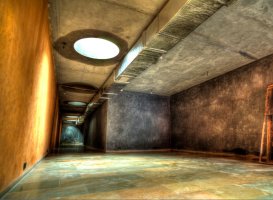 Inside the theatre 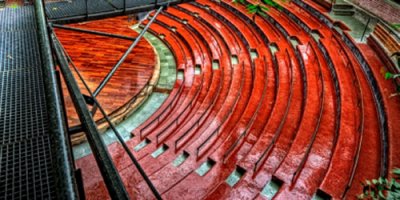 Natarani amphitheatre Natarani had to undergo metamorphosis. When the Government decided to have a Riverfront of Sabarmati river, the riverfront development project impacted the existing Natarani theatre precinct. A major chunk of the stage was lost to the riverfront edge road and sidewalk rendering the theatre inoperable. It was important to attend to the various problems created by this activity. One of the major ones was about the sound. The increased vehicular activity affecting the sound had to be handled first. A sound attenuating wall had to be constructed for acoustical reasons. Uday and Mausumi Andhare of The Indigo Architects of Ahmedabad were invited to attend to various issues of theatre. The renovation was both imperative and important for activities to flourish. It was kept in mind that the reimagined Natarani theatre would take into account the existing infrastructure and the seating capacity. Mallika took me around explaining how a new performance space from the physical attributes and imprints of the old was improved upon. First of all, the debris material and bricks from the demolished sections of the old theatre and the library were to be reused to make lime and 'surkhi' bricks that was used for the construction of foundations for the new building. 'Recycle the old in the making of the new' principle was followed to great advantage. Mrinalini was in favour of maintaining vegetation, preservation of the character of the space. Old tree which was there had to be kept as it was. Human comfort was also to be taken into account. I was shown the suspended catwalk to facilitate state of the art lighting capabilities and flexible use of the stage, so a variety of performances can be mounted there which has free open ended adaptability. The former capacity of seating was increased from 250 to 385, including spaces for differently abled persons. Connectivity to Darpana academy and the access to the new Mrinalini Sarabhai gallery towards the river's edge as a continuum of activity spaces were planned. I went with her to see the gallery which is the first air conditioned gallery in this complex, with enough light coming from the ceiling. Also besides regular exhibition of photographs it will have interactive facilities. There will be space for performance, baithak for music, lectures and lec dems. One major factor of preventing the building from gaining heat was resolved by having all services and green rooms located below the theatre steps. Something technical like to have thermal advantage and longevity was explained to me mentioning the use of lime for dolomite plaster. I did not know much about the principle of 'Thermal draining of the structure'. A rain water-harvesting tank below the stage with capacity of 1.0 lac liters collects all the water from the steps to become a cool thermal storage mass below ground. This water is circulated under the floor slab of the seating tiers to maintain a cool stable environment .The persons occupying the seats must feel comfortable. I sat on the steps and saw fresh air circulating through under seat vents. I was told that it can be de-humidified for comfort and draws its coolness from the already cooled seating steps. Induced ventilation and cooling compensation, maintain the desired ambient temperature in the amphitheatre space. 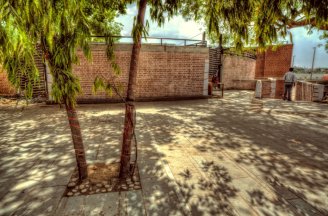 Plaza 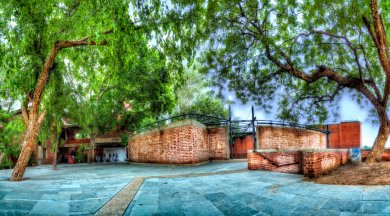 Plaza panorama Mallika showed me various plug points on the wall. So many details have been taken care of in reconstruction of Natarani theatre. The sprung wooden floor has wood from Brazil which lasts more than 20 years. Since it is an open air amphitheatre precautions were taken when it rains. We climbed up the steps and came to the Plaza. There was earlier a library-cum-studio, designed by renowned architect Balkrishna Doshi. It has been removed and now there is a large space as Plaza, where people can assemble before the show. At night before the show starts, audience may assemble in the Plaza for chit chat, social gathering and also watch on the wall projection of announcements of other events. The old Natarani has undergone a fascinating metamorphosis. The inner seven meter high wall is made of serrated bricks and its curves are lined with steel plates. It is painted indigo on the river side outer wall. The outer wall of Natarani on Riverfront has become a place for people to use as an artistic backdrop. Newlyweds come there for photo shoot. The strategic use of warding off outside vehicular and other noises is well achieved. Coming to the end of that wall, Kartikeya Sarabhai showed me the place where Dr. Vikram Sarabhai's statue will be installed. Mallika mentioned that when the Riverfront Road was developed, Natarani was swallowed up and nearly 122 sq m of land was lost in 2015. Darpana lost the case of reclaiming its land and a few months later, Mrinalini Amma passed away in 2016. "It was a time of death, a time of destruction. We had to choose whether to remain in that state or redefine our vision, our dreams and ourselves, because Amma's legacy was not meant for us to be defeated. There is a sense of loss but there is also rebirth. I am sure Amma is proud of us as we are 'never-say-die.'" 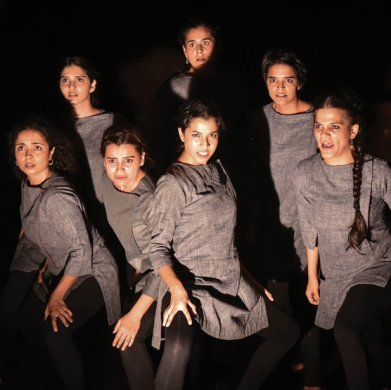 07/07/07 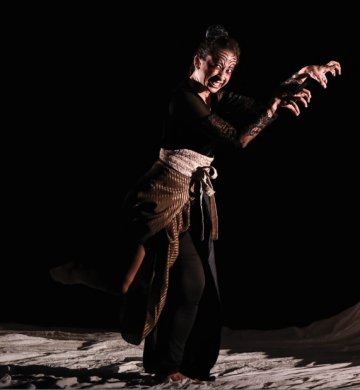 Elephant in the room As a curator, Mallika brings to bear upon her centenary celebrations of Mrinalini Sarabhai, a distinct selection. She has watched hundreds of plays over last two years and over the week had selected eight plays under title 'Sunday to Sunday' which began with Rajat Kapur's One on One 2, a series of monologues. Mallika had also selected among other plays Faezeh Jalali's 07/07/07, a story about an Iranian woman who was executed because she killed her rapist. A piece called 'Item Number' from Pune has a sardonic look at item numbers. The play 'Elephant in the room' which I could see was a riot, a one woman performance, mind boggling and performed by the versatile actor Ellias. The play had won Mahindra Excellence award. Had I not other engagements, I would have stayed back and seen all the plays. 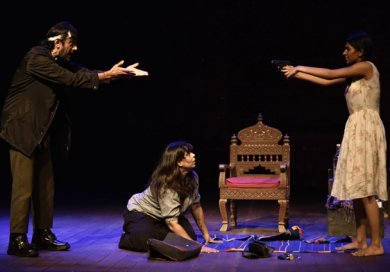 The Cut
I had seen the rehearsal of Darpana's play on Manto, Amrita Pritam and Ismat Chugtai at late night when they were rehearsing on the Plaza. The young actors from different walks of life are full of enthusiasm and energy. Under the leadership and guidance of Mallika and Yadavan Chandran, the festival has several unique features. The week that I spent at Darpana and Natarani has been memorable. Next month in November, Mallika has scheduled a choreography week of three major dancers. Shama Bhate from Pune (Kathak), Vanashree Rao from Delhi (Kuchipudi and Bharatanatyam) and Sharmila Biswas from Kolkata (Odissi) will present their latest choreographic works. And already a big world music event is on collaborating with Alliance Francaise and other institutions. The festival has unusual fare to offer. No wonder new Natarani theatre is all abuzz with exciting activities. I often saw Mallika waking up early morning, doing her yoga, even after late nights. The young dancers came dot at 7am for regular classes. The rehearsal for Darpana's choreographic works was also on. Meetings were held, staff moved around. During the week when the plays were staged, next day theatre workshops were held. Young actors were asking questions, learning new theatre techniques. Mallika tells me: "I want to make Ahmedabad a cultural hub. What after all is a heritage city? Ahmedabad and people who live here cannot be just known for their business skills only. I firmly believe that art that makes you think has to be showcased. Is not asking questions our age old tradition from times immemorial? Look at our Upanishads. They are full of questions. I want our art community to ask questions as art is a tool for social change."  Dr. Sunil Kothari is a dance historian, scholar, author and critic, Padma Shri awardee and fellow, Sangeet Natak Akademi. Dance Critics' Association, New York, has honoured him with Lifetime Achievement award. Post your comments Please provide your name and email id when you use the Anonymous profile in the blog to post a comment. All appropriate comments posted with name & email id in the blog will also be featured in the site. |